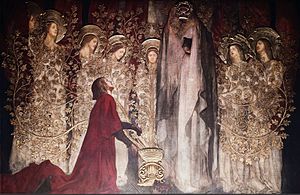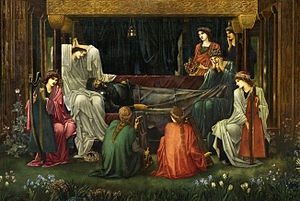 Image via Wikipedia
Image via WikipediaFor a goodly part of this volume, the tales focus on the hero, Tristram, who is very knightly and proper and all that sort of thing. However, he is somewhat unlucky in that he is torn between the code of knighthood, his love for La Beale Isoud. She is said to be fair above all other women. However, she is betrothed to his uncle, King Mark.
King Mark is a cowardly king who does all manner of ill to Tristram. Despite that treatment, including imprisonment, hiring assassins, and killing all his allies, whenever King Mark is in need of aid, Tristram is certain to give it.
These tales tend to be somewhat dry and repetitive. From time to time, I considered putting the book away for another spell. However, I persevered.
The second major part of the tales involve the Sangreal, also known as the Holy Grail. Most, if not all, of King Arthur's Knights of the Round Table begin the quest of the Sangreal. This quest results in the loss of many knights, including the best of them, Sir Galahad, the son of Sir Launcelot.
 Image via WikipediaThis part of the book is quite a bit more exciting to read. It's also quite remarkable how hard the judgment went against even the best of knights. Sir Launcelot is noted as being a grievous sinner and a servant of Satan. But nowhere throughout the text would one come to this conclusion. He is always humble. He is always happy to give glory over to other heroes. Whatever wrong occurs, one can count on him getting involved that it might be righted. It is only Galahad, who is often referred to as a maiden, and his two companions Sir Bors and Sir Percivale, who are pure enough to attain the company of the Sangreal. Launcelot himself, as good as he is, is slandered to be a servant of Satan's.
Image via WikipediaThis part of the book is quite a bit more exciting to read. It's also quite remarkable how hard the judgment went against even the best of knights. Sir Launcelot is noted as being a grievous sinner and a servant of Satan. But nowhere throughout the text would one come to this conclusion. He is always humble. He is always happy to give glory over to other heroes. Whatever wrong occurs, one can count on him getting involved that it might be righted. It is only Galahad, who is often referred to as a maiden, and his two companions Sir Bors and Sir Percivale, who are pure enough to attain the company of the Sangreal. Launcelot himself, as good as he is, is slandered to be a servant of Satan's.Finally, the last two books of the series (books 20 and 21) are about the destruction of King Arthur and the Round Table. It starts off with some of Launcelot's and Arthur's enemies using Launcelot's familiarity with Guenever and loyalty to her and Arthur's ownership of her as her husband as that which divides and will eventually destroy both.
 Image via WikipediaInitially, there is a great deal of resistance. Despite Gawaine being put in a bad light for much of the work, he puts quite a bit up against the plot. However, ultimately, misfortune would collaborate with Alglovale, the primary instigator of the strife.
Image via WikipediaInitially, there is a great deal of resistance. Despite Gawaine being put in a bad light for much of the work, he puts quite a bit up against the plot. However, ultimately, misfortune would collaborate with Alglovale, the primary instigator of the strife.As Launcelot fights for his life against many of the Round Table, two of Gawain's favourite knights and brothers, Sir Gaheris and Sir Gareth, inadvertently get themselves killed by Launcelot who fought wildly and killed whomsoever got within reach. As a result, Sir Gawaine finally does seek to destroy Sir Launcelot.
The fight runs onto France until Arthur's son, Mordred, takes the kingdom in his absence. Ultimately, all the knights of the Round Table are destroyed by what becomes a war between Mordred and Arthur. Shortly thereafter, Guenever and Sir Launcelot become religious figures and then die.
 Image via WikipediaThe death scene for Arthur, where a ship arrives to take him to Avalon, reminded me of the scene from Lord of the Rings when Bilbo Baggins left the world. I can therefore easily see where Tolkien got that scene from.
Image via WikipediaThe death scene for Arthur, where a ship arrives to take him to Avalon, reminded me of the scene from Lord of the Rings when Bilbo Baggins left the world. I can therefore easily see where Tolkien got that scene from.I have read some of the Arthurian tales. But now I have the feeling that I've done a very thorough reading thereof. It always saddens me when I see an Arthurian movie, as too often the stories are nowhere near as good as the books. Hopefully, if I ever have success with any of my works, I would love to start a comic book based on King Arthur.

No comments:
Post a Comment